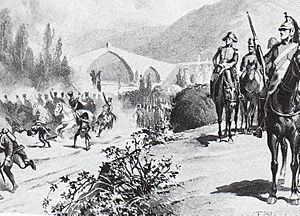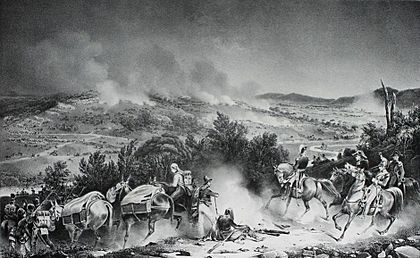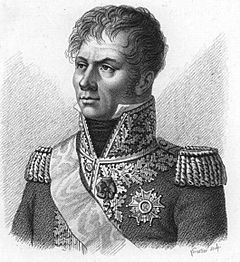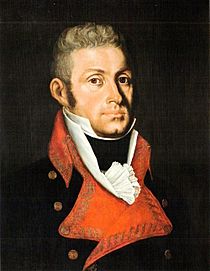Battle of Molins de Rei facts for kids
Quick facts for kids Battle of Molins de Rei |
|||||||
|---|---|---|---|---|---|---|---|
| Part of Peninsular War | |||||||
 Picture of the Battle of Molins de Rei shows the Pont del Diable in the background. The bridge is actually 12 km. north of Molins de Rei in Martorell. |
|||||||
|
|||||||
| Belligerents | |||||||
| Commanders and leaders | |||||||
| Units involved | |||||||
| Strength | |||||||
| 14,000 | 15,000 | ||||||
| Casualties and losses | |||||||
| 400 | 2,200 25 guns |
||||||
The Battle of Molins de Rei was a big fight that happened on December 21, 1808. It was part of the Peninsular War, which was a major conflict in Spain. In this battle, the French army, led by General Laurent Gouvion Saint-Cyr, fought against the Spanish army. The Spanish forces were temporarily led by Theodor von Reding and the Count of Caldagues, because their main commander, Juan Miguel de Vives y Feliu, was not there.
General Saint-Cyr was very clever. He tricked the Spanish by making them think he would attack from the front. But secretly, he sent most of his soldiers across the Llobregat River to attack the Spanish from the side. This surprise move caused the Spanish defense to fall apart. The French won the battle, capturing 1,200 Spanish soldiers, all their cannons, and even the Count of Caldagues himself. This battle took place near Molins de Rei, a town about 15 kilometers (9 miles) west of Barcelona, in Catalonia, Spain.
The Dos de Mayo Uprising in May 1808 surprised the French soldiers who were occupying Spain. By August 1808, the French and Italian soldiers in Barcelona were stuck and in danger of being captured. Emperor Napoleon quickly put together a large army and sent Saint-Cyr to help the soldiers in Barcelona. After a difficult journey, Saint-Cyr defeated a Spanish force at Cardadeu and reached Barcelona. He then decided to push the Spanish army away from the city.
Contents
Why the Battle Happened
The Corunna campaign started with the Battle of Cardedeu.
Spain Under Napoleon's Control
After some agreements in 1807, Emperor Napoleon of France started to show signs of wanting too much power. He tricked the Spanish King Charles IV of Spain and his son Prince Ferdinand into giving up their power. Then, Napoleon announced that his brother, Joseph Bonaparte, would become the new King of Spain.
At the same time, Napoleon moved many French troops into Spain. In February 1808, these soldiers took control of Barcelona and several important forts. On May 2, 1808, there were riots in Madrid, the capital, which were put down harshly by French troops. Soon after, the Spanish people rose up against the French occupation.
Early Fights in Catalonia
A French general named Guillaume Philibert Duhesme was in charge of about 12,700 French and Italian soldiers in Catalonia. Napoleon expected Duhesme to help capture other cities and hold Barcelona. But Duhesme's forces were too small, and the Spanish revolt was very strong.
The French tried twice to clear a mountain pass at El Bruc, but they failed. Duhesme also tried to capture the city of Girona but couldn't. Napoleon realized Duhesme needed help. He sent another general, Honoré Charles Reille, with 8,000 more soldiers. Reille tried to capture the port of Roses but also failed.
In late July, Reille and Duhesme both attacked Girona in what became the Second Siege of Gerona. But the Spanish defenders were strong, and a local militia called the miquelets made it very hard for the French. Duhesme had to leave behind his cannons and supplies to escape back to Barcelona on August 20, 1808.
New French Commander Arrives
Napoleon finally understood how serious the situation in Catalonia was. On August 17, 1808, he appointed Laurent Gouvion Saint-Cyr as the new commander. Saint-Cyr was given 18,000 fresh troops, including very good French and Italian soldiers.
Meanwhile, 10,000 Spanish soldiers were waiting in the Balearic Islands. Their commander, Juan Miguel de Vives y Feliu, was worried that his British allies might try to take the islands. But his soldiers almost rebelled, so Vives finally allowed 5,000 men to sail to the mainland. These troops landed in Catalonia by July 23.
The Spanish leaders in Catalonia appointed a new general, Marquis del Palacio, who started to block Barcelona. About 10,000 more Spanish troops arrived from the Province of Granada. By October 28, Vives replaced Palacio as the main commander. The Spanish army now had about 20,000 infantry and 1,000 cavalry. Vives made the blockade of Barcelona tighter, pushing the French soldiers inside the city walls by November 26. However, Vives was not very quick to act.
Saint-Cyr began the Siege of Roses on November 7, 1808, and Roses surrendered on December 5. This helped secure the French supply lines. Saint-Cyr then arrived near Girona with 17,000 troops. He hoped to draw the Spanish soldiers out of the city, but they stayed inside.
Saint-Cyr knew that a long siege of Girona would take too much time. So, he sent his cannons and supply wagons away and cleverly marched past Girona, leaving some troops behind. Vives thought the French would be stuck at Girona. When he found out Saint-Cyr was moving through the hills, he sent a division under Reding to stop them. Vives finally brought more troops, but he still had many soldiers available that he didn't use. Saint-Cyr completely outsmarted his opponents. He arrived near the village of Cardadeu to find Vives and Reding with only 9,100 soldiers and seven cannons. In the Battle of Cardadeu on December 16, Saint-Cyr's large attack columns broke through the Spanish lines. The French caused 2,500 Spanish casualties while losing only 600 of their own. Vives got separated from his army and escaped by sea.
The Battle of Molins de Rei
Getting Ready for the Fight
On December 16, the Count of Caldagues managed to push back a French attack from Barcelona. But that evening, he heard about the Spanish defeat at Cardadeu. So, Caldagues moved his soldiers behind the Llobregat River, setting up defenses from Molins de Rei in the north to Sant Boi de Llobregat in the south. During their quick retreat, Caldagues left a large food supply in Sarrià for the French.
On the morning of December 17, Saint-Cyr led his army into Barcelona. He was annoyed that the French soldiers who had been trapped in the city didn't come out to greet his victorious troops. When General Duhesme finally appeared, he claimed his forces were not in danger. But Saint-Cyr showed him a letter Duhesme had sent, begging for help because his soldiers were in a terrible situation. Duhesme then left, feeling embarrassed.
After about 1,000 of his militia left, Caldagues had 11,000 troops. Soon, Reding joined them with 3,000 to 4,000 soldiers who had been defeated at Cardadeu. Their defense lines along the Llobregat River were strong and had heavy cannons. However, the lines were too long for an army of 15,000 soldiers to defend properly. The Llobregat River could be crossed in many places, so if the French attacked at one point, they would likely succeed. Since Vives was gone, Reding took command of the Spanish forces. He and Caldagues knew their position was weak, but they didn't know what to do.
Reding and Caldagues wanted to retreat to a very strong position at Ordal, where they planned to build a camp. But retreating to Ordal would open the main road to Lleida for the French. It would also let the French collect crops from the plains. Reding sent a message to Vives, who was in Sitges, asking for instructions. Vives didn't take responsibility, leaving it up to Reding to decide whether to fight or retreat. Vives's answer arrived on the night of December 20–21. To show his bravery, Reding decided to fight.
French and Spanish Forces
Saint-Cyr led four divisions out of Barcelona on the cold morning of December 21, 1808. He left Duhesme in charge of Barcelona with one Italian division. Saint-Cyr's army included divisions led by Chabran, Souham, Pino, and Chabot. Chabran's troops were experienced French soldiers and one Swiss battalion. Souham's French and Pino's Italian divisions were made up of elite troops. Chabot's division had one French battalion and two Neapolitan battalions. The Neapolitan soldiers were generally considered the weakest troops in Europe. Saint-Cyr's force also had a cavalry brigade.
The Battle Begins
Saint-Cyr planned for Chabran's 4,000 soldiers to make a fake attack on the Molins de Rei bridge. While the Spanish generals were busy with this, 14,000 troops from Souham, Pino, and Chabot's divisions would cross the Llobregat River further south. They would then march to attack the Spanish right side.
At 5:00 am, Chabran started his fake attack on the Spanish left. Reding was fooled and sent some troops from his right side to reinforce his left. At 6:00 am, the real French attack began when Saint-Cyr ordered his other three divisions to advance.
Souham's division crossed the river at a place called Sant Joan Despí. The Spanish troops in the center started to move downhill to stop Souham, but they hesitated and didn't attack strongly. Pino and Chabot's divisions crossed even further south at San Feliu, facing little resistance. The French quickly broke through the stretched-out Spanish lines in several places. Chabot's small division on the far left completely went around the Spanish right side. As Chabot's troops moved deeper behind the Spanish lines, the Spanish soldiers fighting against Pino and Souham had to give up their good defensive positions and fall back. The French advance pushed the broken Spanish left and center into a confused mass, sending them fleeing north.
Soon, many retreating Spanish soldiers appeared in front of Chabran. This was the moment for Chabran to turn his fake attack into a real one, but he waited. By the time Chabran's troops finally crossed the Llobregat, most of the Spanish soldiers had already run away. Vives arrived late to the battlefield at this point. Seeing his troops running for their lives, Vives quickly left. Saint-Cyr sent his cavalry to chase the Spanish. They caught the Count of Caldagues when his horse collapsed.
The French captured 1,200 Spanish soldiers, 25 cannons, a huge supply of ammunition, and many muskets that the fleeing Spanish soldiers had thrown away. Another report said the Spanish lost 1,000 soldiers killed or wounded, plus 1,200 captured, along with 25 cannons and a flag. The French lost 400 killed and wounded out of their 18,000 soldiers. A historian named Charles Oman noted that the French didn't have many cannons, so the ones they captured from the Spanish were very useful. He also mentioned that Saint-Cyr's troops didn't bring any cannons with them, and many of Duhesme's cannons were lost earlier.
What Happened Next
The Corunna campaign continued with the Battle of Sahagún.
Most of the defeated Spanish soldiers fled to Tarragona for safety. Others went to Lleida or Tortosa. After the battle, the victorious French troops took control of the area around the Llobregat River and lands to the west, including the important pass at Ordal. Saint-Cyr believed that getting enough food for his army was the most important thing, and reopening his supply line with France was the second. It would be hard for the French to supply Barcelona by sea because British warships were nearby. Also, the land route was blocked by Spanish-held Girona and Hostalric.
Saint-Cyr found other reasons to pause his march. The winter fighting had tired his soldiers, and they needed to rest. Spanish troops near Girona kept bothering Reille's division.
Saint-Cyr might have tried to capture Tarragona, but he thought he would need special equipment and a lot of ammunition to take that strong fortress. He didn't know that most of the local militia had gone home, the regular soldiers were close to rebelling, and the people of Catalonia were in a state of panic. In Lleida, a local man took power and started executing anyone he suspected of being a traitor. Reding finally stopped this by sending soldiers to arrest and execute the tyrant.
When the pressure from Saint-Cyr eased, the Catalans began to regroup. More Spanish troops arrived from Granada and Mallorca. The Spanish leaders convinced the less effective Vives to resign and replaced him with Reding, who was brave, even if not brilliant. The local militia also returned to duty. So, one month after Molins de Rei, the Spanish Army of Catalonia had 30,000 men.
On January 1, 1809, a Spanish general named Lazán ambushed a French battalion, killing or wounding 200 men and capturing 90 more. When the French tried to get revenge, they were pushed back. However, Lazán soon moved his division out of Catalonia to help his brother, José de Palafox y Melci, whose army was fighting in the Second Siege of Zaragoza. Saint-Cyr kept his troops busy gathering food and stopping the local militia. The French troops cleared the El Bruc pass and captured Montserrat but didn't stay there. Some ships managed to get through the British blockade to bring food to Barcelona. Later, a system of convoys was started. The next big battle in Catalonia was the Battle of Valls on February 25, 1809.
See also
 In Spanish: Batalla de Molins de Rey para niños
In Spanish: Batalla de Molins de Rey para niños





